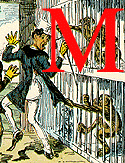 uch scorned and much feared by authors of religious tracts, penny dreadfuls inherited the position of chapbooks as the cheaply produced and priced vehicle for scintillating stories in the late nineteenth century. In fact, despite its generally poor quality production and writing, the penny dreadful occupies an important position in English literature in terms of sheer numbers of sales and circulation alone. Just as with chapbooks, penny dreadfuls began as adult literature and engaged readers with its emphasis on realistic albeit highly sensational stories. Indeed, the bookseller C.A. Stonehill noted in 1935 that "It is highly probably that in its day more people read Thomas Prest's "First False Step" or "The Maniac Father" than had ever heard of a book published in the same decade, entitled Jane Eyre." (Haining 14) Although old and young readers alike enjoyed these lavishly gruesome and overly explicit tales, by the 1860s, penny dreadfuls shifted to primarily engage youngsters (Haining 16). By the early 1880s, there were fifteen different circulating penny dreadfuls (Springhall 568).
uch scorned and much feared by authors of religious tracts, penny dreadfuls inherited the position of chapbooks as the cheaply produced and priced vehicle for scintillating stories in the late nineteenth century. In fact, despite its generally poor quality production and writing, the penny dreadful occupies an important position in English literature in terms of sheer numbers of sales and circulation alone. Just as with chapbooks, penny dreadfuls began as adult literature and engaged readers with its emphasis on realistic albeit highly sensational stories. Indeed, the bookseller C.A. Stonehill noted in 1935 that "It is highly probably that in its day more people read Thomas Prest's "First False Step" or "The Maniac Father" than had ever heard of a book published in the same decade, entitled Jane Eyre." (Haining 14) Although old and young readers alike enjoyed these lavishly gruesome and overly explicit tales, by the 1860s, penny dreadfuls shifted to primarily engage youngsters (Haining 16). By the early 1880s, there were fifteen different circulating penny dreadfuls (Springhall 568).
Haining notes that the rise of youthful heroes most noticeably marks this shift. (17) Although the deeds of murderous barbers such as Sweeney Todd and highwaymen like Dick Turpin continued to circulate amongst English adolescents, these villains were joined by more youthful, though not always more wholesome, protagonists such as 'Charley Wag, the Boy Burgler' or Jack Harkaway. They were also joined by Roman gladiators, Goths, Teutonic knights, Crusaders, heroic apprentices, schoolboys and young working-class lads (Springhall 574).
Edwin J. Brett's Boys of England; A Magazine of Sport, Sensation, Fun and Instruction exemplifies the new focus of penny dreadfuls by promising young readers "to enthral you by wild and wonderful, but healthy fiction" (Charles Stevens in Boys of England 1.1 [24 Nov. 1866]: 15). The Boys of England was an instant success, with a circulation of 150,000 that had almost doubled to 250,000 by 1879 (Drotner 74). Brett continued to produce Young Men of Great Britain (1868), Boys of the Empire (1888) and the Boys' Comic Journal (1883) alongside the Boys of England. (Haining 303) In fact, although penny dreadfuls continued to consist of largely sensational, mostly hack writing, one author, E. Harcourt Burrage rises above the general anonymity to earn the popular epithet, "the boy's Charles Dickens" in writing hundreds of serials, most famously the "Ching-Ching" series and the "Tom Wildrake" series (Haining 318).
Rekated Material
- Magazines: An Introduction
- Evangelical Tracts and Magazines for Children
- Secular Magazines for Victorian Children
- Jack Harkaway of Penny Dreadful Fame
Bibliography
Bratton, J.S. The Impact of Victorian Children's Fiction. London: Croom Helm; New Jersey: Barnes and Noble Books, 1981.
Drotner, Kristin. English Children and their Magazines, 1751-1945. New Haven and London: Yale University Press, 1988.
Haining, Peter, ed. The Penny Dreadful. London: Victor Gollancz, Ltd., 1976.
Hannabuss, C. Stuard. "Nineteenth-century Religious Periodicals for Children." British Journal of Religious Education. Vol. 6, No. 1, (1983), p. 20-40.
Springhall, John. "Disseminating Impure Literature": The 'Penny Dreadful' Publishing Business Since 1860." Economic History Review: New Series, Vol. 47, No. 3, (Aug., 1994), p. 567-584. Accessed on JSTOR, Brown University.
Last modified 12 July 2007